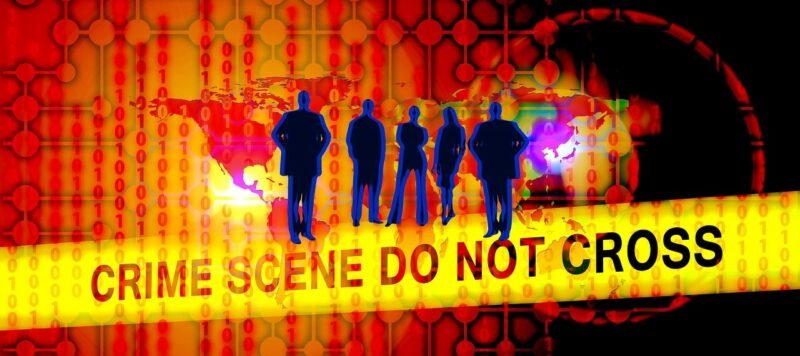10 Unusual Evidence at Crime Scenes
Unusual evidence at crime scenes encompasses materials, objects, or data that differ from what is commonly expected in criminal investigations. Such evidence may consist of rare biological samples, enigmatic digital files, or unusual physical items. In essence, it includes anything that is notably distinct or surprising within the setting of a crime scene.
Importance of Unusual Evidence at Crime Scenes
Unusual evidence is pivotal in crime scene investigations, offering investigators critical clues and insights that may not be obvious at first glance. While conventional evidence like fingerprints, DNA, and weapons are essential, it’s the atypical evidence that can often prompt breakthroughs in otherwise stagnant cases. Such evidence can open up fresh lines of inquiry, illuminate the perpetrator’s motives or methods, and assist in reconstructing the events that occurred.
This article dives into the fascinating realm of atypical evidence found at crime scenes. We will investigate different kinds of atypical evidence, encompassing biological, digital, and physical forms, and scrutinize real-life instances where such evidence was crucial in cracking cases.
Moreover, we will consider the challenges and factors involved in managing atypical evidence, along with the prospective consequences of progress in forensic science. By the conclusion, you will gain an enriched comprehension of the importance of atypical evidence and its influence on crime scene analysis.
Table of Contents
Types of Unusual Evidence at Crime Scenes
Unusual evidence at encompasses a wide range of materials and data that can be found at crime scenes, each offering unique insights into the circumstances surrounding a crime. Let’s explore some of the most common types of unusual evidence:
Biological Evidence
Biological evidence refers to any organic material found at a crime scene that can be analyzed for forensic purposes. While blood, hair, and tissue are typical examples of biological evidence, unusual biological samples can include:
- Unusual DNA samples: This may involve genetic material from unexpected sources such as animals or plants, or DNA profiles that don’t match those of the victim or suspect.
- Animal remains: The presence of animal carcasses or body parts can provide valuable clues about the crime, such as indicating the involvement of animals in the commission of the offense or serving as a means of disposal.
- Unusual plant materials: Plant matter found at crime scenes, particularly rare or exotic species, can offer insights into the location or circumstances surrounding the crime, as well as the activities of those involved.
Digital Evidence
Digital evidence encompasses any electronic data or information that can be collected and analyzed in the course of a criminal investigation. Unusual digital evidence can include:
- Unusual files on electronic devices: This may involve the discovery of cryptic or suspicious files, such as encrypted documents, hidden folders, or unusual file formats, which could provide clues about the perpetrator’s motives or activities.
- Cryptic messages or codes: The presence of encrypted messages, mysterious symbols, or coded communications on electronic devices can present investigators with intriguing challenges and opportunities for deciphering the meaning behind such communications.
- Unusual browsing history or online activities: Unusual internet search queries, frequenting lesser-known websites, or participating in atypical online activities may be indicative of criminal intentions or participation in illegal acts.
Physical Evidence
Physical evidence refers to any tangible objects or materials found at a crime scene that can be analyzed for forensic purposes. Unusual physical evidence may include:
- Unusual weapons or tools: The discovery of unconventional or unexpected weapons or tools at a crime scene, such as improvised weapons or custom-made devices, can provide valuable insights into the methods used by the perpetrator.
- Unusual footprints or tire tracks: unusual shoe prints, tire tracks, or other impressions left at a crime scene can help investigators reconstruct the movements of individuals involved in the crime and potentially identify suspects or vehicles.
- Unusual objects left at the scene: The discovery of unusual or misplaced items at a crime scene, including symbolic objects, ritualistic artifacts, or personal effects not owned by the victim or suspect, can provide critical insights into the perpetrator’s identity, motivations, or psychological state.
In the following sections, we’ll discuss real-life case studies that illustrate the significance of unusual evidence in crime scene investigation.
Case Studies
Let’s examine real-life case studies where the discovery and analysis of unusual evidence played a crucial role in solving crimes. These examples highlight the importance of being attentive to all types of evidence, even those that may initially seem unconventional or insignificant.
Case 1: The Phantom Thumb Drive
In this case, investigators were baffled by the mysterious disappearance of sensitive documents from a high-security government facility. Despite extensive searches and surveillance footage analysis, no suspects were identified. However, during a routine sweep of the premises, a janitor discovered an unusual thumb drive hidden behind a ventilation grate.

Background of the Case
The missing documents were highly classified and contained sensitive information about national security matters. Their disappearance raised concerns about espionage or internal sabotage within the organization.
Discovery of the Unusual Evidence
The janitor’s discovery of the hidden thumb drive raised suspicions, as it appeared to have been deliberately concealed. Forensic analysis revealed encrypted files containing copies of the missing documents, along with traces of malware designed to cover the perpetrator’s tracks.

Role of the Evidence in Solving the Case
The thumb drive provided crucial evidence linking the theft of the documents to an insider with access to the facility’s secure areas. By tracing the digital trail left by the perpetrator, investigators were able to identify and apprehend the individual responsible for the theft, ultimately preventing further breaches of national security.
Case 2: The Mysterious Plant
In this case, a hiker stumbled upon a decomposing body deep in the woods, surrounded by an unusual plant species not native to the area. Investigators were intrigued by the presence of the plant and its potential significance in the investigation.
Background of the Case
The discovery of the body raised suspicions of foul play, as the victim’s cause of death was not immediately apparent. The presence of the unfamiliar plant suggested that the crime scene may have been staged or manipulated.
Discovery of the Unusual Evidence
Botanical experts were called in to examine the plant found at the scene. Analysis of the plant’s pollen and spores led investigators to a remote greenhouse owned by the victim’s estranged spouse, who had a history of volatile behavior.
Analysis of the Plant and Its Significance
Further investigation revealed that the plant was highly toxic and could be used to manufacture a lethal poison. The presence of the plant at the crime scene implicated the spouse in the murder, leading to their arrest and eventual conviction.
Thinking Beyond the Norm: Unconventional Evidence
- Lipstick Smudge on a Glass: A trace of lipstick on a glass or bottle may seem insignificant, but it can provide crucial clues about the identity of a suspect or victim, their whereabouts, or their relationships.
- Hair Fibers on a Toilet Seat: Hair fibers found on a toilet seat can offer insights into the physical characteristics of individuals present at the scene, potentially linking them to suspects or witnesses.
- Unique Sand Composition on Shoes: Sand particles with a distinctive composition found on the bottom of shoes can help narrow down the geographic location where the suspect has been, providing valuable leads for investigators.
- Barcode Analysis for Purchase Tracking: Analyzing the barcode of a purchased item can reveal details about its origin, purchase location, and buyer, aiding in tracking down suspects or identifying stolen goods.
- Unusual Plant Residue on Clothing: Traces of uncommon plant residue found on clothing can indicate specific geographic locations or activities undertaken by suspects, offering valuable contextual information for investigators.
- Unconventional Weapon Choices: Unusual objects used as weapons, such as a household item or improvised tool, can provide insights into the perpetrator’s mindset, motive, or level of planning.
- Inconspicuous Audio Recordings: Unexpected audio recordings captured by household devices or surveillance systems can contain conversations or sounds that provide crucial evidence for solving a case.
- Scented Perfume or Cologne Traces: Traces of a distinct perfume or cologne scent on an object at the crime scene can provide clues about the presence of a specific individual, potentially linking them to the crime.
- Unusual Food Residue: Traces of unusual food residue on utensils or surfaces can offer clues about the suspect’s dietary preferences, recent activities, or social interactions, aiding in suspect identification or alibi verification.
- Unusual Trash Contents: Examination of trash cans, both inside and outside a residence, can yield valuable evidence such as discarded items used in the commission of a crime, unusual packaging or receipts indicating recent purchases, or items that provide insights into the suspect’s lifestyle or activities.

These examples showcase the diversity of unusual evidence that detectives and CSI teams may encounter, highlighting the importance of thinking creatively and investigating every detail, no matter how unconventional, to crack the case.
Challenges and Considerations
While unusual evidence can provide valuable insights into criminal investigations, its discovery and analysis present unique challenges and considerations for law enforcement agencies and forensic experts. Let’s explore some of these challenges:
Preservation of Unusual Evidence at Crime Scenes
Preserving unusual evidence at crime scenes requires careful handling and storage to prevent contamination or degradation. Unlike more traditional forms of evidence, such as fingerprints or DNA, unusual evidence may be fragile or perishable, requiring specialized preservation techniques. For example, biological samples from unusual sources may require immediate refrigeration or freezing to prevent decomposition, while digital evidence may need to be isolated from network access to prevent tampering.
Interpretation and Analysis Challenges
The interpretation and analysis of unusual evidence present unique challenges due to its atypical or nonstandard characteristics. Investigators might not have the necessary expertise or resources to effectively analyze rare biological samples, decode enigmatic messages, or recognize peculiar objects at crime scenes. Moreover, the subjective nature of interpreting unusual evidence often necessitates a multidisciplinary approach among experts to derive precise conclusions.
Legal Considerations Regarding Unusual Evidence
The admissibility of unusual evidence in court proceedings may be subject to legal scrutiny, particularly if its relevance or reliability is called into question. Defense attorneys may challenge the authenticity or significance of unusual evidence at crime scenes, leading to lengthy legal battles and potential delays in the prosecution of criminal cases.
Additionally, the use of specialized forensic techniques or technologies to analyze unusual evidence may raise concerns about privacy rights or constitutional protections, requiring careful consideration of legal and ethical guidelines.
Resource Constraints and Funding Limitations
Investigating and analyzing unusual evidence requires significant resources and expertise, which may be lacking in some law enforcement agencies or forensic laboratories. Budget constraints and funding limitations can further exacerbate these challenges, limiting the availability of specialized equipment, training, and personnel needed to properly handle and analyze unusual evidence. As a result, some cases involving unusual evidence at crime scenes may go unresolved or remain unsolved due to resource constraints and logistical challenges.
In the following section, we’ll explore the future of unusual evidence in crime scene investigation, including advancements in forensic technology and emerging trends in the field.
The Future of Unusual Evidence at Crime Scenes
Despite the challenges and considerations involved in managing atypical evidence, advancements in forensic technology and emerging trends present promising opportunities to enhance the role of such evidence in crime scene investigations. Here are some of these developments:
Advancements in Forensic Technology
Technological advancements continue to revolutionize the field of forensic science, enabling more sophisticated analysis and interpretation of unusual evidence. For example, advances in DNA sequencing technology have made it possible to analyze biological samples from unusual sources with greater accuracy and precision, expanding the potential applications of forensic genetics in criminal investigations.
Similarly, advancements in digital forensics tools and techniques allow investigators to recover and analyze digital evidence from a wide range of devices, including smartphones, computers, and cloud storage services, uncovering hidden clues and insights that may have been previously inaccessible.
Emerging Trends in Unusual Evidence at Crime Scenes
As criminals advance their methods, law enforcement must proactively identify and analyze new trends in atypical evidence. The spread of cryptocurrencies and blockchain technology, for instance, poses fresh challenges and prospects for investigators tasked with deciphering digital currencies and decentralized networks to track illegal and financial transactions.
Likewise, the emergence of biometric authentication and wearable technologies offers novel means to gather and scrutinize biological evidence, including fingerprints, DNA, and physiological data, which can yield critical information about a suspect’s identity and behavior.
Potential Impact on Crime Scene Investigation
The integration of unusual evidence into crime scene investigation holds the potential to revolutionize the way criminal cases are solved and prosecuted. By leveraging advanced forensic technologies and analytical techniques, investigators can uncover hidden clues and insights that may have been overlooked or ignored in the past, leading to more accurate and effective outcomes. Additionally, the use of unusual evidence can help to strengthen the evidentiary basis of criminal cases, enhancing the credibility and reliability of forensic evidence presented in court proceedings.
In the future of unusual evidence in crime scene investigation is bright, with advancements in forensic technology and emerging trends in the field poised to transform the way criminal cases are investigated and prosecuted. By embracing these developments and leveraging the power of unusual evidence, law enforcement agencies can enhance their ability to uncover the truth and deliver justice for victims and communities alike.
Conclusion
In this article, we’ve explored the intriguing world of unusual evidence at crime scenes and its importance in crime scene investigation. From biological samples to digital files and physical objects, unusual evidence can provide valuable insights and clues that may lead to breakthroughs in criminal cases.
We’ve examined various types of unusual evidence, including biological, digital, and physical, and discussed real-life case studies where such evidence played a pivotal role in solving crimes. These examples highlight the significance of being attentive to all types of evidence, even those that may initially seem unconventional or insignificant.
Additionally, we’ve discussed the challenges and considerations associated with handling unusual evidence, such as preservation, interpretation, and legal admissibility. Despite these challenges, advancements in forensic technology and emerging trends in the field offer promising opportunities for enhancing the role of unusual evidence in crime scene investigation.
By recognizing the value of unusual evidence and investing in the resources and expertise needed to analyze it effectively, we can strengthen our collective efforts to combat crime and uphold the principles of justice and accountability.
I hope you found this article enjoyable and informative. Please feel free to leave comments or questions below. Also, consider exploring some of my other articles such as 5 Essential Wound Patterns Found at Crime Scenes.
In addition, click here to read the types of other evidence used in court.
Moreover, if you have an interest in home security, learn how to properly secure your home and protect your family by reading the relevant articles.
Willie McCain






